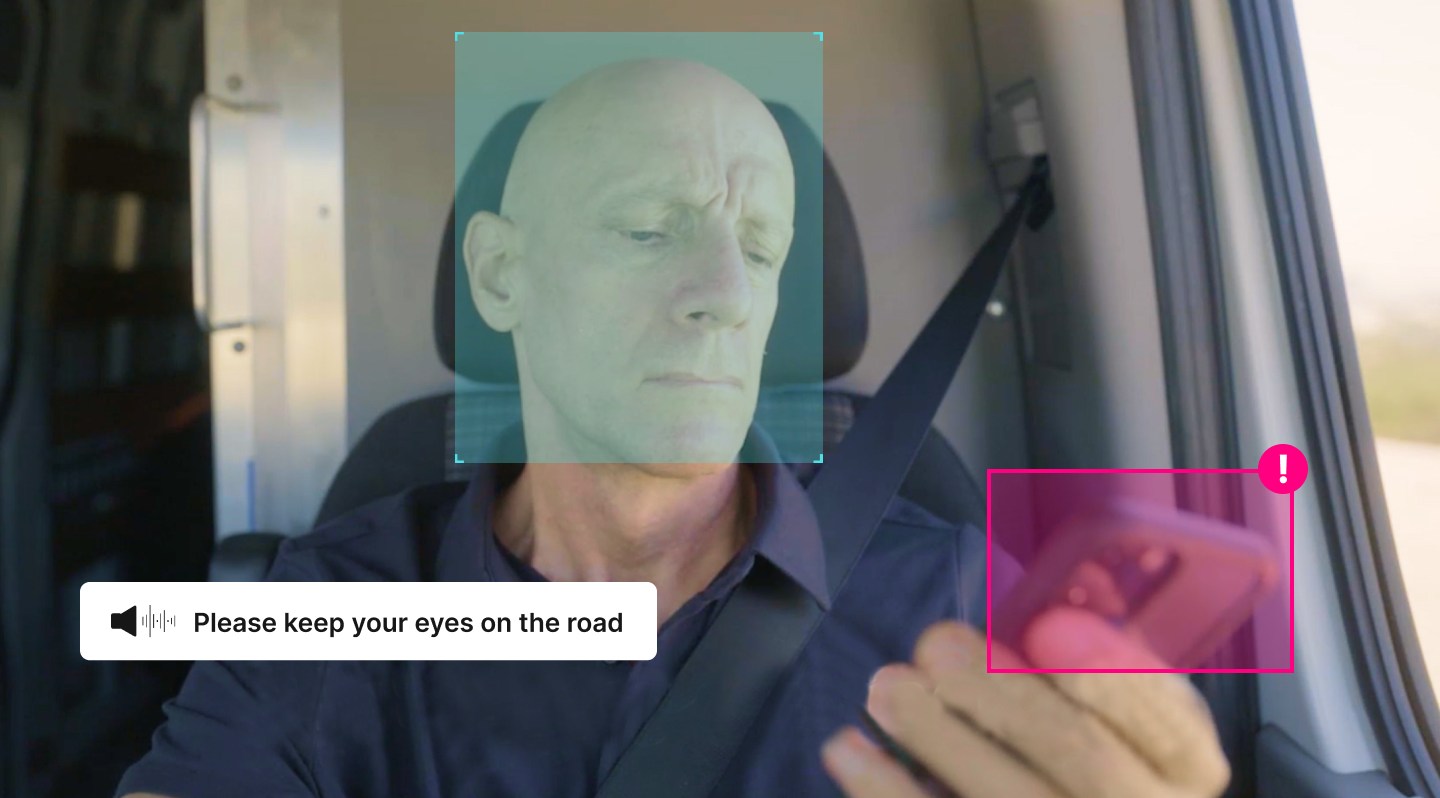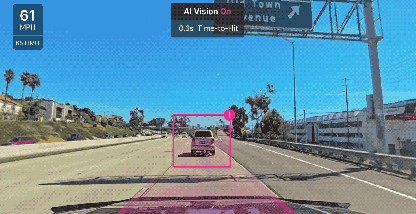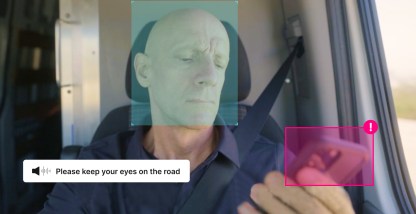Traffic had slowed to a crawl, then to a stop. While most drivers realized traffic was at a standstill, one commercial driver did not.
“The driver wasn’t paying attention,” says Diane Woodruff, DOT Compliance and Safety Manager at Sabel Steel. “They took out about six vehicles in their path, including ours. It was raining. There were accidents everywhere. They were going way too fast.”
In instances just like this, distracted driving claimed 3,522 lives in 2021. Each of these deaths could have been prevented if drivers had kept their eyes on the road.
Commercial workers who spend any length of time driving during the workday are exposed to distracted driving all the time. Sometimes it’s the work of others. Other times, themselves. While fleets can’t keep workers out of harm’s way completely, they can use dual-facing dash cams to root out distracted driving.
As Distracted Driving Awareness Month winds to a close, here’s how Motive customers are using the Motive AI Dashcam to prevent distracted driving and create safer roads.
Dual-facing dash cams ‘instrumental’ to curbing distracted driving
At Texas-based AJL International, training and DOT Compliance Manager Shannon Vaught implemented Motive dual facing AI Dashcams in the company’s fleet of executive buses and cars just over a year ago. Rolling out Motive AI Dashcams was among the first decisions that were made upon Vaught joining AJL.
“We implemented Motive AI Dashcams to set more targeted safety goals and let the data drive our focus,” Vaught says. “We did not have access to much data at the time. We also wanted more visibility into safety performance in real time. The Motive dual-facing AI Dashcams delivered that for us.”
The Motive AI Dashcam has been pivotal to bringing distracted driving to the forefront in commercial fleets. For AJL, the AI Dashcam captures cell phone use, speeding, and lack of seat belt use most frequently.
With its newly enhanced distraction detection capabilities, the Motive AI Dashcam alerts drivers whenever they look down for more than five seconds at speeds faster than 10 mph. Drivers may look down due to drowsiness, cell phone use, smoking, eating, or general inattentiveness.
Whatever the reason, the AI Dashcam recognizes and alerts to distraction almost instantly. With the accuracy of Motive’s artificial intelligence, fleet managers can feel confident knowing that when there’s an alert, there’s a distraction.
“I don’t know how we would curb distracted driving without the dual-facing AI Dashcam,” Vaught says. “It’s been instrumental in rooting out unsafe behaviors in our fleet. I don’t know how you could monitor distracted driving without it.”
Video-based coaching the key to safer performance
According to the National Distracted Driving Coalition, dual-facing dash cams help stop distracted driving in real time, reducing the risk of injury or death. The NDDC’s article “How Technology Can Help Reduce Driver Distraction” points to a study commissioned by U.S. Department of Transportation. The study shows that dash cams and driver coaching work in tandem to reduce the frequency and severity of unsafe events.
For Vaught, automated coaching through the Motive Driver App is the first line of defense. Whenever a distracted driving event takes place, the dash cam video is automatically sent to the driver through the Driver App. The driver can then review the video, along with personalized coaching tips that help them improve.
“Automated coaching with Motive is awesome,” Vaught says, “It makes things so much quicker when you have as many drivers and vehicles as we do. The only thing I have to do is make sure drivers are logging in to the Motive Driver App and following up on the messages and notifications in there. Not having to coach in person saves me a lot of time.”
However, Vaught does coach in person when a driver continues to demonstrate unsafe behavior. The in-person session helps him review safety best practices with the driver.
Education and growth via dash cam footage
When distracted driving is captured on the AI Dashcam, Vaught uses the video clips as educational tools. When one driver was caught using an iPad, for example, Vaught aired the video in the break room as an example of behavior to avoid. “Over time, drivers have become more appreciative of the AI Dashcam as a growth tool,” he says.
At Sabel Steel, Woodruff has ramped up her safety messaging in support of Distracted Driving Awareness Month. “I tell my team, ‘When you’re driving and you’re thinking about picking up your phone, treat it like your family is in the car ahead. You’re working for us, you’re driving our truck. But safety is your responsibility.’ God forbid you get distracted, hit somebody, and injure them or worse. I mean, that’s something you have to live with.”
Don’t settle for distracted driving in your fleet
Download our fleet safety coaching guide and start building a safety culture today.
Distracted driving by the numbers
Did you know that…
8% of fatal vehicle-related accidents involve distracted driving
According to Forbes, “while this is a far lower percentage of crashes than impaired driving, which accounts for approximately 30% of all fatal accidents, it still reflects the extreme risk presented by driver distraction.”
324,652 were injured in accidents due to distracted driving in 2020
Not all distracted driving crashes are fatal. But driver inattention can also result in collisions that cause serious injury. The toll of driver distraction is far greater when considering crashes that caused injury but were not fatal. In fact, 324,652 people were hurt in distracted driving crashes in 2020.
Cell phone use is involved in 12% of road-related accidents
While there are many causes of driver distraction, cell phones remain a major obstacle to focused driving. The National Traffic Safety Administration reports that phone use is involved in 12% of all car accidents on U.S. roadways.
Distracted driving happens most between 6 p.m. and 11 p.m.
Distracted driving is a problem at all hours, but inattention increases in the evening. “In fact, between 6 and 11 p.m., drivers were distracted for an average of 1:56 minutes per driving hour,” Forbes writes.
Distracted driving happens least between 6 a.m. and 9 a.m.
There is some good news. Drivers are typically more focused on the road during their morning commute. Between the hours of 6 and 9 a.m., motorists are distracted for only an average of 1:04 minutes per hour of driving. This is nearly half as much time for unfocused driving as evening hours.
Taking your eyes off the road for 5 seconds at 55 mph is equivalent to traveling the length of a football field without looking
“Many drivers don’t realize how far they can travel even when distracted for a brief period,” Forbes writes. “The reality is, motorists can drive the equivalent of an entire football field blind if they take their eyes off the road for just five seconds when they are traveling at 55 mph. With so much ground covered, it’s not a surprise that the risks of a crash are high when motorists lose focus.”
Source: ”Distracted Driving Statistics and Facts in 2023,” Forbes, Feb. 23, 2023.










